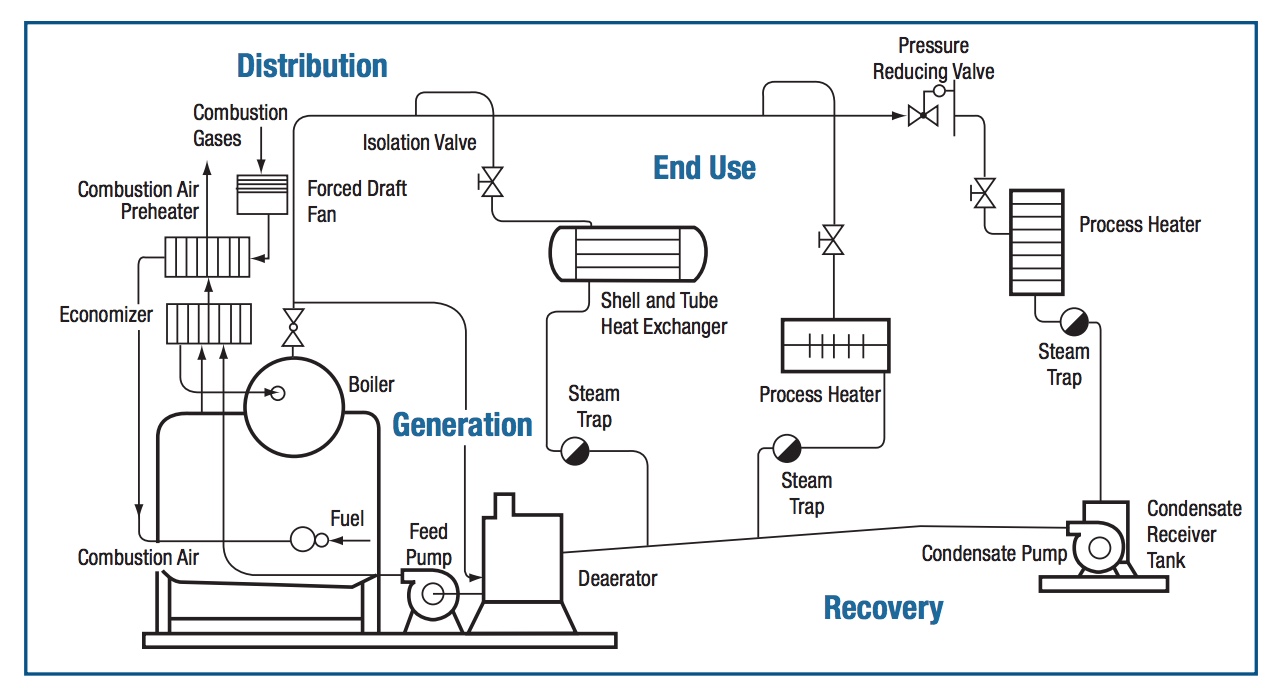 3. 10%-15%
Steam systems account for about 30% of the total energy used in industrial applications for product output. These systems can be indispensable in delivering the energy needed for process heating, pressure control, mechanical drives, separation of components, and production of hot water for process reactions.
As energy costs continue to rise, industrial plants need effective ways to reduce the amount of energy consumed by their steam systems. Industrial steam systems can include generation, distribution, end use, and recovery components, as shown in the diagram. End-use equipment includes heat exchangers, turbines, fractionating towers, strippers, and chemical reaction vessels. Steam systems can also feature superheaters, combustion air preheaters, feedwater economizers, and blowdown heat exchangers to boost system efficiency.
According to the U.S. Department of Energy’s Industrial Technologies Program, making steam systems more efficient throughout industry could reduce annual plant energy costs by several billion dollars and environmental emissions by millions of metric tons. Typically, plants that assess their steam systems uncover potential steam system energy use and cost savings that range from 10% to 15% per year.
Facts & Figures
3. 10%-15%
Steam systems account for about 30% of the total energy used in industrial applications for product output. These systems can be indispensable in delivering the energy needed for process heating, pressure control, mechanical drives, separation of components, and production of hot water for process reactions.
As energy costs continue to rise, industrial plants need effective ways to reduce the amount of energy consumed by their steam systems. Industrial steam systems can include generation, distribution, end use, and recovery components, as shown in the diagram. End-use equipment includes heat exchangers, turbines, fractionating towers, strippers, and chemical reaction vessels. Steam systems can also feature superheaters, combustion air preheaters, feedwater economizers, and blowdown heat exchangers to boost system efficiency.
According to the U.S. Department of Energy’s Industrial Technologies Program, making steam systems more efficient throughout industry could reduce annual plant energy costs by several billion dollars and environmental emissions by millions of metric tons. Typically, plants that assess their steam systems uncover potential steam system energy use and cost savings that range from 10% to 15% per year.
Facts & Figures
- About one-third of the nation’s total energy use is consumed in U.S. industrial facilities; nearly one-ninth is used by steam systems.
- Industry consumes more than 40% of the nation’s total use of natural gas.
- Even plants with energy management programs can often save 10% to 15% more using best practices to increase their energy efficiency.
- System improvements can often reduce the energy costs of a typical industrial steam system by 10% to15%.
- Energy efficiency improvements can reduce utility bills and improve your plant’s bottom line.
- Many improvements require little or no extra investment, are easy to implement, and have payback times of less than a year.
- Strategies that increase energy efficiency often reduce operating and maintenance costs, minimize waste, and enhance production.
- Energy efficiency helps to reduce negative impacts on the environment and can enhance corporate community relations programs.
Test Your Knowledge: Energy Assessments
